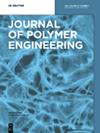Tribological behavior of ultra-high molecular weight polyethylene (UHMWPE) for acetabular replacement under frictional heat based on molecular dynamics
IF 1.7
4区 工程技术
Q4 POLYMER SCIENCE
引用次数: 0
Abstract
Abstract Hip prostheses generate higher frictional heat than natural joints at the joint head-socket interface during in vivo service, resulting in higher temperatures of the contact surfaces and surrounding synovial fluid, which affects the frictional properties of the prosthetic material. In order to clarify the influence mechanism of frictional heat on the tribological behavior of ultra-high molecular weight polyethylene (UHMWPE) for acetabular replacement, the tribological tests of three contact pairs were carried out under different synovial fluid temperatures in this research. Furthermore, the movement processes of the molecular chain structure of UHMWPE during friction were simulated by Materials Studio (MS), and the mechanism of oxidative degradation was discussed. The results show that the temperature of synovial fluid has a significant effect on the friction and wear resistance of UHMWPE and the lubrication characteristics of synovial fluid. At the same time, the action mechanism of the proteins in the synovial fluid that gradually precipitate with the temperature rise to participate in the friction process is related to the friction pair material and contact mode. The synergistic effect of temperature rise and friction will accelerate the oxidative degradation reaction of UHMWPE and form ketone and alcohol oxides on its surface, thus reducing its wear resistance.基于分子动力学的超高分子量聚乙烯(UHMWPE)髋臼置换材料在摩擦热作用下的摩擦学行为
摘要在体内使用过程中,髋关节假体在关节-头-窝界面处产生的摩擦热高于自然关节,导致接触表面和周围滑液的温度更高,从而影响假体材料的摩擦性能。为了阐明摩擦热对用于髋臼置换的超高分子量聚乙烯(UHMWPE)摩擦学行为的影响机制,本研究在不同滑液温度下对三种接触副进行了摩擦学试验。此外,利用Materials Studio(MS)模拟了UHMWPE分子链结构在摩擦过程中的运动过程,并对其氧化降解机理进行了探讨。结果表明,滑液温度对超高分子量聚乙烯的摩擦磨损性能和滑液的润滑特性有显著影响。同时,滑液中随着温度升高逐渐沉淀的蛋白质参与摩擦过程的作用机制与摩擦副材料和接触方式有关。温度升高和摩擦的协同作用会加速UHMWPE的氧化降解反应,并在其表面形成酮和醇的氧化物,从而降低其耐磨性。
本文章由计算机程序翻译,如有差异,请以英文原文为准。
求助全文
约1分钟内获得全文
求助全文
来源期刊

Journal of Polymer Engineering
工程技术-高分子科学
CiteScore
3.20
自引率
5.00%
发文量
95
审稿时长
2.5 months
期刊介绍:
Journal of Polymer Engineering publishes reviews, original basic and applied research contributions as well as recent technological developments in polymer engineering. Polymer engineering is a strongly interdisciplinary field and papers published by the journal may span areas such as polymer physics, polymer processing and engineering of polymer-based materials and their applications. The editors and the publisher are committed to high quality standards and rapid handling of the peer review and publication processes.
 求助内容:
求助内容: 应助结果提醒方式:
应助结果提醒方式:


